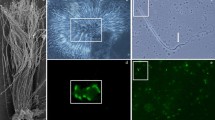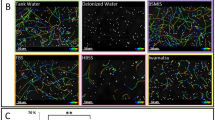Abstract
Despite their importance as a research model, particularly in developmental toxicology investigations, there are few established standards for maintaining Xenopus spp. frogs in the laboratory. The authors review the literature on handling, housing, nutrition, and breeding of Xenopus spp. for optimal oocyte production.
This is a preview of subscription content, access via your institution
Access options
Subscribe to this journal
We are sorry, but there is no personal subscription option available for your country.
Buy this article
- Purchase on Springer Link
- Instant access to full article PDF
Prices may be subject to local taxes which are calculated during checkout
Similar content being viewed by others

References
Dawson, D.A., Schultz, T.W. & Schroeder, E.C. Laboratory care and breeding of the African clawed frog. Lab Anim. (NY) 21, 31–36 (1992).
Green, S.L. Factors affecting oogenesis in the South African clawed frog (Xenopus laevis). Comp. Med. 52, 307–312 (2002).
Schaeffer, D.O. & Schultz, T.W. in Laboratory Animal Medicine 2nd edn (eds. Fox, J.G., Anderson, L.C., Loew, F.M. & Quimby, F.W.) 793–826 (Academic Press, San Diego, CA, 2002).
Gurdon, J.B. in The Biology of Xenopus (eds. Tinsley, R.C. & Kobel, H.R.) 3–8 (Clarendon Press, Oxford, 1996).
Nieuwkoop, P.D. & Faber, J. Normal Table of Xenopus laevis (Daudin) (Garland Publishing, New York, 1994).
Dumont, J.N., Schultz, T.W., Buchanan, M. & Kai, G. in Symposium on the Application of Short-term Bioassays in the Analysis of Complex Environmental Mixtures III (eds. Waters M.D., Sandhu, S.S., Claxton, L., Chernoff, N. & Nesnow, S.) 393–405 (Plenum Press, New York, 1983).
American Society for Testing and Materials. ASTM E1439-98: Standard Guide for Conducting the Frog Embryo Teratogenesis Assay: Xenopus (FETAX). (ASTM, West Conshohocken, PA, 1998).
Burkhart, J.G. et al. Induction of mortality and malformation in Xenopus laevis embryos by water sources associated with field frog deformities. Environ. Health Perspect. 106, 841–848 (1998).
Kobel, H.R., Loumont, C. & Tinsley, R. in The Biology of Xenopus (eds. Tinsley, R.C. & Kobel, H.R.) 9–33 (Clarendon Press, Oxford, 1996).
Tinsley, R.C., Loumont, C. & Kobel, H.R. in The Biology of Xenopus (eds. Tinsley, R.C. & Kobel, H.R.) 35–59 (Clarendon Press, Oxford, 1996).
Kreil, G. in The Biology of Xenopus (eds. Tinsley, R.C. & Kobel, H.R.) 263–277 (Clarendon Press, Oxford, 1996).
Hilken, G., Dimigen, J. & Iglauer, F. Growth of Xenopus laevis under different laboratory rearing conditions. Lab Anim. (NY) 29, 152–162 (1995).
Kaplan, M.L. An enriched environment for the African clawed frog. Lab Anim. (NY) 22, 25–27 (1993).
Major, N. & Wassersug, R.J. Survey of current techniques in the care and maintenance of the African clawed frog (Xenopus laevis). Contemp. Topics Lab. Anim. Sci. 37, 57–60 (1998).
Stewart, P.L. An efficient, economical multicompartment tank for housing Xenopus laevis. Lab. Anim. Sci. 33, A30 (1994).
Rogers, W.P., Simpson, T.W., Jones, L.M. & Renquist, D.M. An innovative aquatic non-recirculating system for use in housing African clawed frogs (Xenopus laevis). Contemp. Topics Lab. Anim. Sci. 36, 72–74 (1997).
Bartholomew, J.L., Driessen, J.L., Walker-Harrison, P. & Riggs, R.R. Continuous flow aquatic system for long-term housing of Xenopus laevis. Contemp. Topics Lab. Anim. Sci. 32, 37 (1993).
Hilken, G., Willmann, G.H.F., Dimigen, J. & Iglaver, F. Preference of Xenopus laevis for different housing conditions. Scand. J. Lab. Anim. Sci. 21, 71–80 (1994).
Hoogstraten-Miller, S. & Dunham, D. Practical identification methods for African clawed frogs. Lab Anim. (NY) 26, 36–38 (1997).
Donnelly, M.A., Guyer, C., Juterbock, J.E. & Alford, R.A. in Measuring and Monitoring Biological Diversity: Standard Methods for Amphibians (eds. Heyer, W.R., Donnelly, M.A., McDiarmid, R.W., Hayek, L.-A.C. & Foster, M.S.) 277–284 (Smithsonian Institution Press, Washington, DC, 1994).
Wu, M. & Gerhart, J. Raising Xenopus in the laboratory. Methods Cell Biol. 36, 3–18 (1991).
Dawson, D.A. & Bantle, J.A. Development of a reconstituted water medium and preliminary validation of the frog embryo teratogenesis assay—Xenopus (FETAX). J. Appl. Toxicol. 7, 237–244 (1987).
Feder, M.E., Seale, D.B., Boraas, M.E., Wassersug, R.J. & Gibbs, A.G. Functional conflicts between feeding and gas exchange in suspension-feeding tadpoles, Xenopus laevis. J. Exp. Biol. 110, 91–98 (1984).
Dumont, J.N. Oogenesis in Xenopus laevis (Daudin). I. Stages of oocyte development in laboratory maintained animals. J. Morphol. 136, 153–179 (1972).
Smith, I.D., Xu, W.L. & Varnold, R.L. Oogenesis and oocyte isolation. Methods Cell Biol. 36, 45–60 (1991).
Crawshaw, G.J. in The Care and Use of Amphibians, Reptiles and Fish in Research (eds. Schaeffer, D.O., Kleinow, K.M. & Krulisch, L.) 41–48 (Scientists Center for Animal Welfare, Bethesda, MD, 1992).
Schaeffer, D.O. in Anesthesia and Analgesia in Laboratory Animals (eds. Kohn, D.F., Wixson, S.K., White, W.J. & Benson, G.J.) 337–378 (Academic Press, San Diego, 1997).
Bantle, J.A., Dumont, J.N., Finch, R.A. & Linder, G. Atlas of Abnormalities: A Guide for the Performance of FETAX (Oklahoma State University Publications Department, Stillwater, OK, 1991).
Author information
Authors and Affiliations
Corresponding author
Rights and permissions
About this article
Cite this article
Schultz, T., Dawson, D. Housing and Husbandry of Xenopus for Oocyte Production. Lab Anim 32, 34–39 (2003). https://doi.org/10.1038/laban0203-34
Received:
Accepted:
Issue Date:
DOI: https://doi.org/10.1038/laban0203-34
This article is cited by
-
More time for aliens? Performance shifts lead to increased activity time budgets propelling invasion success
Biological Invasions (2023)
-
Phenotypic variation in Xenopus laevis tadpoles from contrasting climatic regimes is the result of adaptation and plasticity
Oecologia (2022)
-
Adaption of a dermal in vitro method to investigate the uptake of chemicals across amphibian skin
Environmental Sciences Europe (2016)
-
The effects of a fungicide and chytrid fungus on anuran larvae in aquatic mesocosms
Environmental Science and Pollution Research (2015)
-
Alternative housing for Xenopus laevis
Lab Animal (2008)


